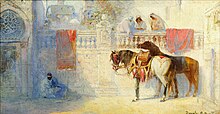Douglas Arthur Teed
At age nine, his father left the family to develop a religious sect called "Koreshanity" after experiencing what he claimed was a divine vision.
While sitting in the laboratory where he practiced medicine and alchemy, Cyrus reported "a relaxation at the... back part of the brain, and a peculiar buzzing tension at the forehead.
"[1] Cyrus Teed claimed this was a calling to spread the word on the true nature of our cellular cosmogony, and to bridge the gap between science and religion.
[2] Cyrus described the messenger as: "Gracefully pendant from the head, and falling in golden tresses of profusely luxuriant growth over her shoulders, her hair added to the adornment of her personal attractiveness.
Dr. Teed persisted in his beliefs, neglecting his duties at home, and eventually settled a communal colony called "The Koreshan Unity".
The American Eagle of August 1973 reports that letters from Cyrus Teed indicated affection for his wife and child, and in spite of criticism, Delia accepted him as the messianic personality of the age.
Douglas Arthur Teed began painting as a small boy in Utica having opened his own study by the age of fourteen.
Teed's oriental paintings dating prior to 1908 are likely to be studies of the works of popular European Orientalists such as Jean-Léon Gérôme, whose colorful and romantic portraits of the Eastern world fascinated him.
Due to the isolation of his journey, Douglas Arthur Teed shared no involvement in the progression of the contemporary market's taste.
Teed's more conservative, impressionistic depictions of the Middle East were well received, filling the drawing rooms of the city's elite.
In a 1924 review of the Annual Exhibition for American Artists, Mr. R. Poland (then Director of Education at the Detroit Institute of Arts) wrote, "...as to landscapes, Mr. Douglas Arthur Teed... has brought the beholder to intimate communion with nature.
Four "conservative" artists who were rejected by the jury were: Percy Ives, Francis Paulus, John Morse, and Charles Waltensperger.
This studio, called "Teed's Castle" by locals,[17] was on the property of a wealthy diplomat in the foreign service, James T. DuBois.
The Susquehanna County census for 1900 lists Teed, D. Arthur, occupation artist, and his wife, George, as owning a mortgaged farm house in Great Bend Township, Pennsylvania.
Teed would take his easel outdoors and the "gentle man with the mustache" would paint, while his wife sketched in water color.
Teed exhibited a charming sense of humor in an anecdote from a Binghamton woman, who was a small girl at the time, "He named the out-house at Salt Springs the 'Spider Retreat'," she recalls.
[19] She also remembered being impressed by the massive gold wedding ring which Douglas had designed for his wife, "It was adorned with beautiful cupids.
Douglas even dedicated a poem to his father for his birthday (known to the Unity as "The Solar Festival") on October 18, 1905, entitled, The Lost Muse.
Thus began his treatment of the figure as an element in space, casting subjects against the romantic landscape – a vibrant rush of environment acting as a reflection of temper.
Accurate depictions of foliage, included with the abounding beauty of the countryside, were utilized by American artists at the time to create an awe-inspiring mood in their works.
These were aesthetic tenets made popular by Sir Edmund Burke's treatise anticipating classical Romanticism, A Philosophical Enquiry into the Origin of Our Ideas of the Sublime and Beautiful.
As Teed refined his aesthetic, he began to approach his subjects less as strict anatomical studies, and more in the vein of the foliage of the classical American landscape—in a delicate application of paint; as the vision which guided his hand, immemorial.
Teed studied every aesthetic style of the late nineteenth and early twentieth centuries, continually searching for a successful means of conveying his passion; compelled to portray on canvas the spiritual aura.
Douglas Teed lived a quiet and humble life, never exhibiting the eccentric follies of the acclaimed masters he admired.
The Boston Evening Transcript calls Teed "a man of high ambitions, with a fine sense of color, a just appreciation of values and a close observer of the subtle and delicate variations of the sensitive gamut... Rather than concentrate on specific forms, the artist has developed an overall pattern of color, light, and impasto which adds cohesiveness to the compositions.
He staged "worlds of atmosphere, looking forth at us through ethereal light, through shadows..."[29] Although he never chose to alleviate realistic representation altogether, Teed's paintings were largely the product of a passionate imagination, whose emotions materialized in the works' creation.
"[30] He stands as an example of the continuous strain of romanticism used by American artists; heirs to the deep-seated religious, cultural, and intellectual convictions of a young nation founded on visionary daring and integrity.
[31] The work of Douglas Arthur Teed is currently housed in the Koreshan State Historic Site, the Arnot Art Museum, and countless private collections around the world.


